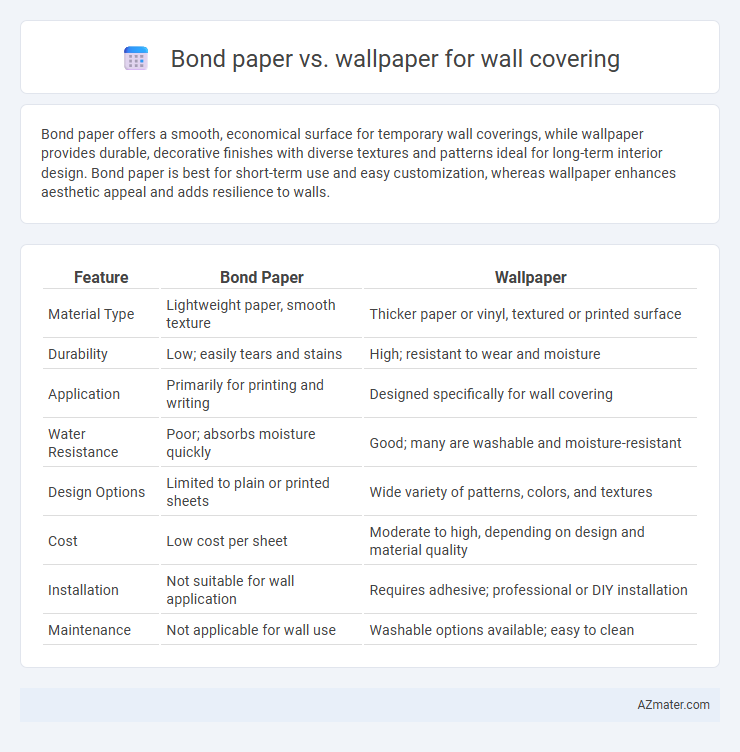Bond paper offers a smooth, economical surface for temporary wall coverings, while wallpaper provides durable, decorative finishes with diverse textures and patterns ideal for long-term interior design. Bond paper is best for short-term use and easy customization, whereas wallpaper enhances aesthetic appeal and adds resilience to walls.
Table of Comparison
| Feature | Bond Paper | Wallpaper |
|---|---|---|
| Material Type | Lightweight paper, smooth texture | Thicker paper or vinyl, textured or printed surface |
| Durability | Low; easily tears and stains | High; resistant to wear and moisture |
| Application | Primarily for printing and writing | Designed specifically for wall covering |
| Water Resistance | Poor; absorbs moisture quickly | Good; many are washable and moisture-resistant |
| Design Options | Limited to plain or printed sheets | Wide variety of patterns, colors, and textures |
| Cost | Low cost per sheet | Moderate to high, depending on design and material quality |
| Installation | Not suitable for wall application | Requires adhesive; professional or DIY installation |
| Maintenance | Not applicable for wall use | Washable options available; easy to clean |
Introduction to Wall Covering Options
Wall covering options include both bond paper and wallpaper, each offering distinct textures and durability for interior design. Bond paper is typically smooth, budget-friendly, and ideal for temporary or minimalistic wall treatments. Wallpaper provides a wider range of patterns, finishes, and heavier materials suited for long-lasting, decorative installations.
What is Bond Paper?
Bond paper is a high-quality, durable writing or printing paper typically used for official documents, letterheads, and stationery, known for its strength and smooth finish. Unlike wallpaper, which is designed specifically for decorative wall covering with various textures and patterns, bond paper serves practical purposes and is not intended for wall decor. Its weight usually ranges from 50 to 100 gsm, making it unsuitable for the durability and aesthetic needs of wall applications compared to specialized wallpaper materials.
What is Wallpaper?
Wallpaper is a decorative material used to cover and enhance the appearance of interior walls, typically made from paper, vinyl, or fabric printed with patterns or textures. Unlike bond paper, which is primarily designed for writing or printing, wallpaper features a thicker, more durable composition allowing it to adhere smoothly and withstand wear in home or commercial environments. Modern wallpapers may include removable or washable options, offering versatility in design and maintenance compared to traditional wall covering solutions.
Durability: Bond Paper vs Wallpaper
Bond paper offers moderate durability for wall coverings, suitable for short-term or temporary applications but prone to tearing and wear over time. Wallpaper, made from vinyl or coated materials, provides superior durability, with resistance to moisture, stains, and fading, ideal for long-lasting decorative finishes. The choice depends on the desired longevity and environmental conditions of the space.
Aesthetic Appeal and Design Variety
Bond paper offers a smooth, matte finish with limited patterns, making it suitable for minimalistic and understated wall designs. Wallpaper provides a vast array of textures, colors, and intricate patterns, allowing for bold statements and diverse aesthetic styles in interior decor. The choice between bond paper and wallpaper significantly impacts the room's visual appeal and design versatility.
Cost Comparison: Bond Paper vs Wallpaper
Bond paper provides a budget-friendly option for wall covering, typically costing between $0.10 to $0.50 per square foot, making it ideal for short-term or temporary applications. Wallpaper ranges from $1 to $5 per square foot depending on material and design complexity, offering more durability and aesthetic variety but at a higher initial investment. Considering installation, bond paper is easier and cheaper to apply, while wallpaper often requires professional installation, increasing overall expenses.
Installation Process and Ease
Bond paper offers a simpler installation process, often requiring just adhesive and precise measuring, making it ideal for DIY projects. Wallpaper typically demands more skill, involving careful alignment of patterns and use of paste or pre-pasted backing, which can lead to longer installation times. Both materials require clean, smooth walls, but bond paper's lighter weight generally results in easier handling and quicker setup.
Maintenance and Cleaning Requirements
Bond paper offers low maintenance with easy cleaning using mild soap and water, making it suitable for high-traffic areas prone to stains. Wallpaper requires more careful upkeep, often needing specialized cleaning agents and gentle handling to avoid damage or color fading. Both materials benefit from prompt stain removal, but wallpaper generally demands more attention to maintain its appearance over time.
Environmental Impact and Sustainability
Bond paper, often made from recycled fibers, offers a more eco-friendly option for wall covering due to its biodegradability and lower production energy compared to wallpaper that typically contains vinyl and non-recyclable materials. Wallpaper manufacturing involves synthetic adhesives and PVC coatings, leading to higher carbon emissions and challenging disposal processes that contribute to landfill waste. Choosing bond paper can reduce environmental impact by promoting renewable resources and facilitating easier recycling, supporting sustainability initiatives in interior design.
Best Uses: Choosing Between Bond Paper and Wallpaper
Bond paper is best suited for temporary or budget-friendly wall coverings, ideal for art projects, design proofs, or short-term event decorations. Wallpaper offers durable, decorative finishes with various textures and patterns, perfect for long-term interior design enhancements in residential or commercial spaces. Selecting between the two depends on durability needs, visual impact, and installation permanence.

Infographic: Bond paper vs Wallpaper for Wall covering
 azmater.com
azmater.com